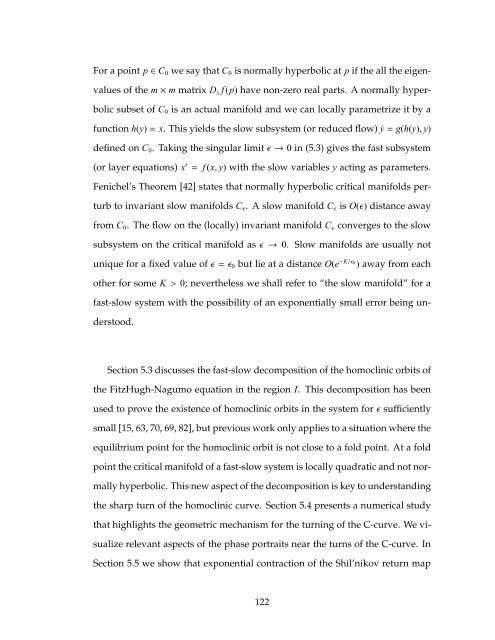multiple time scale dynamics with two fast variables and one slow ...
multiple time scale dynamics with two fast variables and one slow ...
multiple time scale dynamics with two fast variables and one slow ...
You also want an ePaper? Increase the reach of your titles
YUMPU automatically turns print PDFs into web optimized ePapers that Google loves.
For a point p∈C0 we say that C0 is normally hyperbolic at p if the all the eigen-<br />
values of the m×m matrix Dx f (p) have non-zero real parts. A normally hyper-<br />
bolic subset of C0 is an actual manifold <strong>and</strong> we can locally parametrize it by a<br />
function h(y)= x. This yields the <strong>slow</strong> subsystem (or reduced flow) ˙y=g(h(y), y)<br />
defined on C0. Taking the singular limitǫ→ 0 in (5.3) gives the <strong>fast</strong> subsystem<br />
(or layer equations) x ′ = f (x, y) <strong>with</strong> the <strong>slow</strong> <strong>variables</strong> y acting as parameters.<br />
Fenichel’s Theorem [42] states that normally hyperbolic critical manifolds per-<br />
turb to invariant <strong>slow</strong> manifolds Cǫ. A <strong>slow</strong> manifold Cǫ is O(ǫ) distance away<br />
from C0. The flow on the (locally) invariant manifold Cǫ converges to the <strong>slow</strong><br />
subsystem on the critical manifold asǫ → 0. Slow manifolds are usually not<br />
unique for a fixed value ofǫ=ǫ0 but lie at a distance O(e −K/ǫ0 ) away from each<br />
other for some K> 0; nevertheless we shall refer to “the <strong>slow</strong> manifold” for a<br />
<strong>fast</strong>-<strong>slow</strong> system <strong>with</strong> the possibility of an exp<strong>one</strong>ntially small error being un-<br />
derstood.<br />
Section 5.3 discusses the <strong>fast</strong>-<strong>slow</strong> decomposition of the homoclinic orbits of<br />
the FitzHugh-Nagumo equation in the region I. This decomposition has been<br />
used to prove the existence of homoclinic orbits in the system forǫ sufficiently<br />
small [15, 63, 70, 69, 82], but previous work only applies to a situation where the<br />
equilibrium point for the homoclinic orbit is not close to a fold point. At a fold<br />
point the critical manifold of a <strong>fast</strong>-<strong>slow</strong> system is locally quadratic <strong>and</strong> not nor-<br />
mally hyperbolic. This new aspect of the decomposition is key to underst<strong>and</strong>ing<br />
the sharp turn of the homoclinic curve. Section 5.4 presents a numerical study<br />
that highlights the geometric mechanism for the turning of the C-curve. We vi-<br />
sualize relevant aspects of the phase portraits near the turns of the C-curve. In<br />
Section 5.5 we show that exp<strong>one</strong>ntial contraction of the Shil’nikov return map<br />
122
















